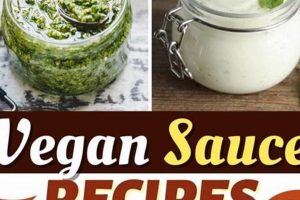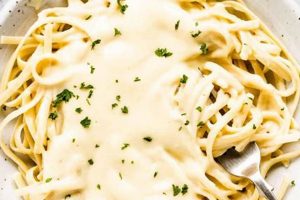A preparation designed to emulate the texture and flavor of traditional nacho cheese sauce, formulated entirely from plant-based ingredients, constitutes a significant development in culinary arts. Common ingredients include cashews, potatoes, carrots, nutritional yeast, and spices. These components are often blended to achieve a smooth, creamy consistency analogous to that of dairy-based cheese sauces.
The rise in popularity of plant-based diets has fueled the demand for acceptable substitutes for familiar foods. This particular sauce offers an alternative for individuals adhering to vegan, vegetarian, or dairy-free dietary restrictions, allowing them to enjoy nachos and other dishes traditionally served with cheese. Its development represents a shift towards more inclusive and sustainable food practices. Its flexibility extends to various applications, including dipping, topping, and incorporating into cooked dishes.
Consequently, considerations regarding ingredient selection, preparation techniques, and potential variations are relevant factors to explore in greater detail. Focus will be given to methods that produce optimal flavor, texture, and overall culinary experience. This will include examining preparation methods like soaking nuts, ingredient ratios, and cooking parameters.
Preparation Enhancement Strategies
Optimizing the preparation yields enhanced flavor and textural characteristics. The following guidelines offer avenues for improvement.
Tip 1: Cashew Selection: Employ raw, unsalted cashews. These provide a neutral base, allowing the other flavor components to be more pronounced. Pre-soaking the cashews in hot water for a minimum of thirty minutes softens them, facilitating a smoother blend.
Tip 2: Nutritional Yeast Measurement: Nutritional yeast contributes a cheesy flavor. Precise measurement is crucial; excessive quantities can impart a bitter aftertaste. Begin with a conservative amount and adjust to taste.
Tip 3: Vegetable Broth Utilization: Incorporate high-quality vegetable broth instead of water. This adds depth of flavor and complexity to the base sauce.
Tip 4: Spice Optimization: Experiment with various spices, such as smoked paprika, garlic powder, onion powder, and chili powder. Each spice introduces a unique dimension to the flavor profile. Gradually increase the quantity of each spice and asses the flavour.
Tip 5: Blending Technique: A high-speed blender is recommended to achieve a completely smooth, velvety texture. If a standard blender is used, blend for a longer duration and strain the sauce through a fine-mesh sieve to remove any residual solids.
Tip 6: Acidic Balance: Incorporate a small amount of lemon juice or apple cider vinegar to enhance the flavor. The acidity cuts through the richness of the cashews and adds brightness.
Tip 7: Heat Management: Gentle simmering after blending allows the flavors to meld together. Avoid boiling, as this can alter the texture and lead to a grainy consistency.
Adherence to these preparation enhancement strategies contributes to a more palatable and texturally appealing final product. Consistent application of these tips allows for consistent replications.
The subsequent sections will delve into potential recipe variations and serving suggestions.
1. Cashew Preparation
Cashew preparation is a fundamental determinant in the overall quality and success of the plant-based alternative. Proper preparation ensures the desired texture, flavor, and consistency are achieved in the final sauce.
- Soaking Duration
The duration for which cashews are soaked directly impacts their softness and blendability. Insufficient soaking results in a gritty texture, while excessive soaking can dilute the cashew flavor. The ideal soaking period typically ranges from 30 minutes in boiling water to several hours in cold water. The time directly affects the degree of emulsion, and subsequently, the mouthfeel of the vegan sauce.
- Water Temperature
The water temperature used during soaking influences the rate at which cashews soften. Hot water expedites the softening process, reducing the required soaking time. Cold water requires a more extended soaking period, but some argue it preserves more of the cashew’s natural flavor. This choice affects time management and flavor impact.
- Cashew Quality
The initial quality of the cashews themselves is a significant factor. Raw, unsalted cashews are preferred, as salted cashews can impart unwanted saltiness to the final sauce, while roasted cashews alter the flavor profile. Using broken cashew pieces may accelerate the soaking process due to increased surface area, but whole cashews offer more uniform flavor consistency.
- Rinsing Procedure
Thoroughly rinsing the cashews after soaking removes any residual phytic acid, which can inhibit nutrient absorption and potentially impart a slightly bitter flavor. The rinsing process also removes any lingering debris or impurities from the cashews. A proper rinsing procedure is an important step to improve the overall taste and digestiblity of the final product.
Therefore, meticulous attention to these preparation facets, including soaking duration, water temperature, initial cashew quality, and rinsing procedure, significantly elevates the palatability, texture, and overall success of a cashew-based nacho cheese alternative. Neglecting these elements will increase the likelihood of unsatisfactory results.
2. Nutritional Yeast Quality
Nutritional yeast, a deactivated yeast strain, is a critical component that dictates the “cheesy” flavor profile of a plant-based nacho cheese alternative. The quality of the nutritional yeast used exerts a direct and substantial influence on the final outcome. Inferior-quality nutritional yeast may impart a bland, musty, or even bitter taste, undermining the intended emulation of traditional dairy-based nacho cheese flavor. In contrast, high-quality nutritional yeast contributes a savory, umami-rich characteristic often described as nutty or cheesy. For instance, a recipe using fresh, brightly colored nutritional yeast with a high concentration of glutamic acid, a natural flavor enhancer, will generally yield a significantly more palatable sauce than a recipe using old, dull nutritional yeast.
Furthermore, the texture of nutritional yeast impacts its distribution and incorporation within the sauce. Finely flaked nutritional yeast disperses more evenly and dissolves more readily during blending and heating, resulting in a smoother, more homogeneous sauce. Coarsely ground nutritional yeast, on the other hand, may result in a gritty or uneven texture. The source and processing methods of the nutritional yeast also influence its nutritional content. Some brands are fortified with additional vitamins, particularly B vitamins, while others are not. This variation affects the sauce’s overall nutritional profile, providing a secondary, albeit less critical, consideration for recipe formulation. The selection and use of specific strains of nutritional yeast has shown different outcomes. Some manufacturers offer a ‘blend’ of yeast strains as well.
In conclusion, the careful selection of high-quality nutritional yeast is paramount for achieving a successful plant-based nacho cheese alternative. Consideration should be given to the yeast’s flavor, texture, and nutritional content. Experimentation with different brands and varieties may be necessary to identify the optimal product for achieving the desired taste and consistency. A direct cause-and-effect relationship exists between the yeast’s inherent quality and the final outcome of the vegan sauce; therefore, it is a variable that demands attention during the process of recipe formulation and execution.
3. Blending Consistency
Achieving the appropriate blending consistency is paramount in the successful execution of a plant-based nacho cheese analogue. Inadequate or improper blending significantly impairs the texture and overall palatability, undermining the desired emulation of traditional dairy-based cheese sauces. The degree of smoothness directly correlates with the perception of quality; a grainy or chunky sauce is generally considered undesirable, while a velvety, homogenous consistency is highly preferred.
- Equipment Selection
The type of blending equipment employed directly influences the attainable consistency. High-powered blenders, capable of generating significant shear force, are typically required to break down the fibrous components of ingredients such as cashews and vegetables fully. Standard blenders or food processors may struggle to achieve the same level of smoothness, potentially leaving residual particulates. The selection of equipment represents a critical initial decision that impacts the achievable outcome.
- Ingredient Preparation Impact
The prior preparation of ingredients influences the blending process. As previously noted, cashews require soaking to soften their structure and facilitate emulsification. Similarly, pre-cooking vegetables, such as potatoes or carrots, reduces their resistance to blending. Insufficient preparation necessitates longer blending times, potentially overheating the motor and negatively impacting the final texture.
- Liquid-to-Solid Ratio Adjustment
The ratio of liquid to solid ingredients directly affects the viscosity of the blended sauce. Insufficient liquid results in a thick, paste-like consistency, while excessive liquid produces a thin, watery sauce. Fine-tuning the liquid-to-solid ratio is essential for achieving the desired pourable, yet cohesive, texture. Common liquids include water, vegetable broth, or plant-based milks, each contributing slightly different flavor profiles.
- Blending Duration and Speed Control
The duration and speed at which the ingredients are blended significantly impact the final consistency. Extended blending times, particularly at high speeds, generate heat, which can denature proteins and alter the sauce’s texture. Incremental increases in blending speed, coupled with intermittent pauses to prevent overheating, offer a more controlled approach. Observation of the sauce’s texture during blending allows for real-time adjustments, ensuring the desired smoothness is achieved without compromising the structural integrity.
These facets underscore the significance of meticulous attention to blending parameters when crafting a plant-based cheese sauce. The selection of appropriate equipment, careful ingredient preparation, precise liquid-to-solid ratio adjustments, and controlled blending duration and speed collectively determine the textural characteristics of the final product. Therefore, a thorough understanding of these elements is essential for achieving the desired outcome: a smooth, creamy, and palatable analogue to traditional dairy-based nacho cheese sauce.
4. Spice Level
Spice level is a critical, subjective component directly influencing the perceived quality and acceptance of a plant-based nacho cheese sauce. The deliberate manipulation of spices, ranging from mild to intense, offers a spectrum of flavor profiles tailored to individual preferences. Inadequate spicing results in a bland and uninteresting sauce, failing to emulate the complexity of traditional dairy-based variants. Conversely, excessive spicing can overwhelm the other flavors, rendering the sauce unpalatable. The selection and proportion of spices necessitate careful consideration and precise execution.
The impact of spice level extends beyond mere taste. Capsaicin, the active compound in chili peppers, stimulates the trigeminal nerve, creating a sensation of heat that contributes to the overall sensory experience. Furthermore, specific spices, such as smoked paprika or cumin, contribute smoky and earthy notes, respectively, adding depth and complexity to the flavor profile. For example, a “mild” plant-based nacho cheese sauce might incorporate a small amount of turmeric for color and a pinch of garlic powder for subtle flavor. A “medium” sauce may include chili powder, cumin, and smoked paprika for a more pronounced taste, while a “hot” sauce could incorporate cayenne pepper or chopped jalapeos to deliver a significant heat component. Adjustments to these spice combinations directly determine the sauce’s overall character and appeal. Each spice adds depth and should be used with attention. A ‘hot’ spice can mask or overwhelm a more delicate flavor, even if it is not used at levels that feel particularly spicy.
In conclusion, the management of spice levels within a plant-based cheese analogue requires a nuanced understanding of both flavor chemistry and individual preferences. The selection and proportion of spices are not arbitrary but rather deliberate choices that shape the sauce’s identity and determine its overall success. Achieving the optimal balance between flavor and heat presents a considerable challenge, necessitating careful experimentation and iterative refinement. Proper understanding is paramount, and improper executions can change a flavour profile rapidly. Therefore, mastery of spice level control is essential for producing a plant-based nacho cheese alternative that satisfies a broad range of palates.
5. Liquid Ratio
The liquid ratio within a plant-based nacho cheese preparation constitutes a fundamental determinant of the sauce’s ultimate texture, consistency, and overall palatability. An imbalance in this ratio directly affects the sauce’s ability to adhere to tortilla chips or other snack foods, as well as its mouthfeel and perceived richness. Insufficient liquid results in a thick, pasty consistency that is difficult to pour or spread, while excessive liquid yields a thin, watery sauce lacking body and flavor intensity. The specific ingredients employed in the recipetypically including cashews, potatoes, carrots, and nutritional yeastexhibit varying degrees of water absorption, necessitating careful calibration of the liquid component. For instance, a recipe utilizing a higher proportion of potatoes may require a greater liquid volume to achieve the desired smoothness, while a cashew-dominant recipe may demand less.
Variations in blending equipment also influence the optimal liquid ratio. High-powered blenders generate more shear force, effectively breaking down solids and reducing the need for added liquid. Conversely, less powerful blenders may require a higher liquid volume to facilitate smooth blending. Moreover, the desired application of the sauce impacts the ideal ratio. A sauce intended for dipping typically requires a thicker consistency than one used as a topping for baked dishes, where some evaporation is expected during cooking. Consider a scenario where two batches of plant-based sauce are prepared using identical ingredients, except for the liquid ratio. The batch with a higher liquid proportion might exhibit a glossy sheen and smooth texture immediately after blending, but it could separate upon standing, resulting in a watery layer at the bottom. The batch with the lower liquid proportion, while initially appearing thicker, might solidify into an unappetizing paste upon cooling.
Ultimately, achieving the correct liquid balance requires a nuanced understanding of ingredient interactions and careful observation throughout the preparation process. Experienced cooks often adjust the liquid volume incrementally, assessing the sauce’s texture and consistency at various stages. In summary, the liquid ratio represents a critical control point in crafting a successful plant-based imitation. Imprecise management of this element invariably leads to compromised textural qualities and diminished culinary appeal.
6. Heating Process
The application of heat during and after the initial preparation significantly influences the textural characteristics, flavor profile, and overall stability of plant-based cheese alternatives. This manipulation extends beyond simply warming the final product for consumption; it constitutes a critical step in optimizing the sauce’s inherent qualities and prolonging its palatable state. The heating process facilitates the amalgamation of flavors, encourages emulsification of fats, and alters the starch structure within the sauce, all of which contribute to the final sensory experience.
- Flavor Amalgamation
Gentle simmering promotes the intermingling of individual flavor compounds, resulting in a more cohesive and harmonious taste profile. Spices, such as garlic powder, onion powder, and smoked paprika, release their aromatic oils during heating, infusing the entire sauce with their characteristic notes. Acids, like lemon juice or apple cider vinegar, mellow and integrate more seamlessly with the other ingredients. This process of flavor amalgamation mitigates any harsh or disjointed tastes that may be present immediately after blending, enhancing the overall gustatory experience.
- Starch Gelatinization
Many plant-based cheese alternative recipes incorporate starch-rich ingredients like potatoes or tapioca starch to achieve a thicker consistency. Heating these starches in the presence of water causes gelatinization, a process in which the starch granules absorb water, swell, and form a network that traps liquid and increases viscosity. The extent of gelatinization is directly proportional to the temperature and duration of heating. Insufficient heating results in a thin, watery sauce, while excessive heating can lead to a gummy or pasty texture. Controlled heating is thus essential for achieving the desired level of thickness and smoothness.
- Emulsion Stabilization
Fats, often derived from cashews or other nuts, contribute to the creaminess and richness of a plant-based cheese sauce. However, these fats can separate from the water phase during storage, resulting in an undesirable oily layer on the surface. Heating the sauce after blending promotes emulsification, a process in which the fat droplets are dispersed evenly throughout the water phase and stabilized by emulsifiers present in the ingredients, such as lecithin in cashews. This stabilization process requires careful temperature control, as excessive heating can destabilize the emulsion, leading to fat separation.
- Microbial Control and Shelf Life
The application of heat reduces the microbial load within the sauce, thereby extending its shelf life. While plant-based cheese sauces are generally less susceptible to spoilage than dairy-based cheeses, they can still harbor bacteria and molds that degrade their quality over time. Heating the sauce to a temperature of at least 165F (74C) effectively kills most vegetative bacteria, significantly prolonging its palatable state. This pasteurization process is particularly important for sauces intended for commercial sale or prolonged storage.
These considerations demonstrate that the heating process is far more than a simple warming procedure; it constitutes a crucial step in optimizing the flavor, texture, and stability of vegan preparations. Meticulous attention to temperature control, heating duration, and ingredient interactions is essential for achieving a successful imitation of traditional dairy-based nacho cheese alternatives. The controlled application of thermal energy allows for the transformation of raw ingredients into a cohesive, flavorful, and texturally appealing sauce that meets the expectations of discerning consumers.
7. Ingredient Freshness
The quality and character of a plant-based nacho cheese sauce are inextricably linked to the freshness of its constituent ingredients. Deterioration in ingredient freshness compromises the sauce’s flavor, texture, and overall nutritional value. Utilizing fresh ingredients is not merely a matter of culinary preference but a fundamental requirement for achieving a palatable and appealing final product.
- Cashew Quality and Oil Rancidity
Cashews, owing to their high oil content, are susceptible to rancidity. Rancid cashews impart a bitter, unpleasant flavor to the sauce, rendering it unpalatable. Employing cashews with a recent purchase date, stored in airtight containers in cool conditions, mitigates the risk of rancidity. Visual inspection for discoloration and olfactory assessment for any off-odors are essential quality control measures. The utilization of fresh cashews ensures a smooth, creamy texture and a subtly sweet flavor, forming the foundation of a desirable sauce.
- Nutritional Yeast Flavor Degradation
Nutritional yeast, responsible for the “cheesy” flavor, undergoes flavor degradation over time, particularly when exposed to air and moisture. Stale nutritional yeast loses its characteristic savory notes, imparting a muted or even unpleasant flavor to the sauce. Purchasing nutritional yeast in smaller quantities, storing it in airtight containers in a cool, dry place, and regularly assessing its aroma ensures optimal flavor contribution. Fresh nutritional yeast exhibits a distinctly savory, umami-rich aroma, while stale yeast may have a faint or musty odor.
- Spice Potency and Aromatic Volatility
Spices, essential for imparting depth and complexity, lose their potency and aromatic compounds over time. Ground spices, due to their increased surface area, degrade more rapidly than whole spices. Employing freshly ground spices or purchasing ground spices in small quantities and storing them in airtight containers protects their flavor integrity. Assessing the aroma of spices before incorporation into the sauce provides a reliable indicator of their freshness. Faded color and diminished aroma suggest a loss of potency. For example, smoked paprika, a common ingredient, must exhibit a strong, smoky aroma to contribute its intended flavor profile effectively.
- Vegetable Integrity and Water Content
Vegetables like potatoes and carrots, frequently incorporated for texture and sweetness, undergo changes in texture and flavor as they age. Wilting, softening, and the development of off-flavors detract from the sauce’s overall quality. Employing firm, unblemished vegetables with vibrant color ensures optimal flavor and textural contribution. Furthermore, older vegetables exhibit a higher water content, potentially affecting the sauce’s final consistency. A fresh carrot, for instance, contributes a subtle sweetness and a smooth texture, while an aged or wilted carrot imparts a less desirable flavor and watery consistency.
In conclusion, the utilization of fresh ingredients represents a non-negotiable aspect of producing a palatable and high-quality plant-based nacho cheese sauce. Neglecting ingredient freshness inevitably compromises the sauce’s flavor, texture, and overall appeal, resulting in a substandard culinary experience. Prioritizing the procurement, storage, and assessment of ingredient freshness is paramount for achieving a successful outcome.
Frequently Asked Questions
The following addresses common inquiries regarding the creation of plant-based nacho cheese sauces, focusing on technical aspects and potential challenges.
Question 1: What is the optimal cashew-to-liquid ratio for achieving a smooth consistency?
The precise ratio varies depending on cashew quality and blender power; however, a starting point of 1 cup raw cashews to 3/4 cup liquid (water or plant-based milk) is recommended. Adjustments should be made incrementally based on the texture observed during blending.
Question 2: How can bitterness in the sauce, potentially stemming from nutritional yeast, be mitigated?
Bitterness can arise from excessive nutritional yeast or its inherent quality. Begin with a smaller quantity (e.g., 2-3 tablespoons per recipe) and increase to taste. Utilizing a reputable brand of nutritional yeast known for its mild flavor profile is also advisable. A small amount of lemon juice or apple cider vinegar can also help.
Question 3: What methods are effective for preventing the sauce from separating upon cooling?
Sauce separation often results from inadequate emulsification or starch gelatinization. Ensure cashews are soaked sufficiently and blended thoroughly. Incorporating a small amount of tapioca starch or cornstarch and simmering the sauce gently promotes a stable emulsion. A high-powered blender also aids in emulsion stability.
Question 4: Can frozen cashews be used, and what are the potential implications?
Frozen cashews are acceptable, but thawing them completely prior to soaking is essential. Freezing may alter the texture slightly, potentially requiring a longer soaking duration to achieve optimal softness. This increases water content and therefore adjustments must be made.
Question 5: What are suitable substitutes for cashews in individuals with nut allergies?
Sunflower seeds or cooked white beans can serve as alternatives, though the flavor profile will differ. Sunflower seeds possess a naturally slightly bitter profile; therefore roasting them may be useful. White beans require careful seasoning to mimic the richness and creaminess of cashews. Adjustments to liquid ratios may also be required.
Question 6: What is the recommended shelf life of a plant-based nacho cheese alternative, and what storage practices are advised?
When stored in an airtight container in the refrigerator, a homemade plant-based cheese sauce typically remains palatable for 3-5 days. Freezing is possible, but the texture may change upon thawing. Employing proper sanitation during preparation is crucial to minimize microbial contamination and extend shelf life.
These frequently asked questions highlight the key considerations for successful plant-based preparation. Careful attention to these aspects ensures the creation of a palatable and visually appealing alternative.
The following section discusses recipe variations and ingredient innovations within the framework of plant-based cuisine.
vegan nacho cheese sauce recipe
This exploration into the preparation of a “vegan nacho cheese sauce recipe” has emphasized the critical parameters governing its successful execution. Achieving a palatable and texturally appropriate alternative to traditional dairy-based versions necessitates a meticulous approach to ingredient selection, preparation techniques, and process control. The quality of the cashews, the character of the nutritional yeast, the blending consistency, the balancing of the spices, the precision of the liquid ratio, appropriate heating applications and ingredient freshness each contributes significantly to the final outcome. The success of a plant-based variant hinges on mastering each of these elements.
Given the rising demand for plant-based dietary options, further refinement of this culinary pursuit remains essential. The continued exploration of alternative ingredients, innovative processing methods, and enhanced understanding of flavor interactions will undoubtedly lead to even more convincing and satisfying plant-based analogues. The advancement of “vegan nacho cheese sauce recipe” formulations presents a valuable contribution to the expanding landscape of sustainable and inclusive cuisine. With increasing consumer demand for alternatives, we can expect to see continued growth and improvements in the available options.







